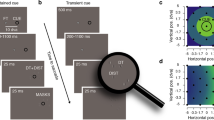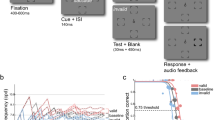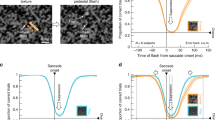Abstract
Perception and action are tightly coupled: visual responses at the saccade target are enhanced right before saccade onset. This phenomenon, presaccadic attention, is a form of overt attention—deployment of visual attention with concurrent eye movements. Presaccadic attention is well-documented, but its underlying computational process remains unknown. This is in stark contrast to covert attention—deployment of visual attention without concurrent eye movements—for which the computational processes are well characterized by a normalization model. Here, a series of psychophysical experiments reveal that presaccadic attention modulates visual performance only via response gain changes. A response gain change was observed even when attention field size increased, violating the predictions of a normalization model of attention. Our empirical results and model comparisons reveal that the perceptual modulations by overt presaccadic and covert spatial attention are mediated through different computations.
This is a preview of subscription content, access via your institution
Access options
Access Nature and 54 other Nature Portfolio journals
Get Nature+, our best-value online-access subscription
$29.99 / 30 days
cancel any time
Subscribe to this journal
Receive 12 digital issues and online access to articles
$119.00 per year
only $9.92 per issue
Buy this article
- Purchase on Springer Link
- Instant access to full article PDF
Prices may be subject to local taxes which are calculated during checkout








Similar content being viewed by others
Data availability
The data that support the findings of this paper are available at https://github.com/hsinhungli/overt-covert-attention.
Code availability
The analysis code used in this paper is available at https://github.com/hsinhungli/overt-covert-attention.
References
Kowler, E., Anderson, E., Dosher, B. & Blaser, E. The role of attention in the programming of saccades. Vis. Res. 35, 1897–1916 (1995).
Deubel, H. & Schneider, W. X. Saccade target selection and object recognition: evidence for a common attentional mechanism. Vis. Res. 36, 1827–1837 (1996).
Hoffman, J. E. & Subramaniam, B. The role of visual attention in saccadic eye movements. Percept. Psychophys. 57, 787–795 (1995).
Montagnini, A. & Castet, E. Spatiotemporal dynamics of visual attention during saccade preparation: independence and coupling between attention and movement planning. J. Vis. 7, 8–16 (2007).
Deubel, H. The time course of presaccadic attention shifts. Psychological Res. 72, 630–640 (2008).
Rolfs, M. & Carrasco, M. Rapid simultaneous enhancement of visual sensitivity and perceived contrast during saccade preparation. J. Neurosci. 32, 13744–13752a (2012).
Hanning, N. M., Szinte, M. & Deubel, H. Visual attention is not limited to the oculomotor range. Proc. Natl Acad. Sci. USA 116, 9665–9670 (2019).
Collins, T., Heed, T., Doré-Mazars, K. & Röder, B. Presaccadic attention interferes with feature detection. Exp. Brain Res. 201, 111–117 (2010).
Li, H.-H., Barbot, A. & Carrasco, M. Saccade preparation reshapes sensory tuning. Curr. Biol. 26, 1564–1570 (2016).
Li, H.-H., Pan, J. & Carrasco, M. Presaccadic attention improves or impairs performance by enhancing sensitivity to higher spatial frequencies. Sci. Rep. 9, 2659 (2019).
Ohl, S., Kuper, C. & Rolfs, M. Selective enhancement of orientation tuning before saccades. J. Vis. 17, 2 (2017).
Moore, T., Tolias, A. S. & Schiller, P. H. Visual representations during saccadic eye movements. Proc. Natl Acad. Sci. USA 95, 8981–8984 (1998).
Mazer, J. A. & Gallant, J. L. Goal-related activity in V4 during free viewing visual search: evidence for a ventral stream visual salience map. Neuron 40, 1241–1250 (2003).
Fischer, B. & Boch, R. Enhanced activation of neurons in prelunate cortex before visually guided saccades of trained rhesus monkeys. Exp. Brain Res. 44, 129–137 (1981).
Moore, T. & Zirnsak, M. Neural mechanisms of selective visual attention. Annu. Rev. Psychol. 68, 47–72 (2017).
Steinmetz, N. A. & Moore, T. Eye movement preparation modulates neuronal responses in area V4 when dissociated from attentional demands. Neuron 83, 496–506 (2014).
Carrasco, M. Visual attention: the past 25 years. Vis. Res. 51, 1484–1525 (2011).
Carrasco, M. & Barbot, A. How attention affects spatial resolution. Cold Spring Harb. Symp. Quant. Biol. 79, 149–160 (2015).
Maunsell, J. H. Neuronal mechanisms of visual attention. Annu. Rev. Vis. Sci. 1, 373–391 (2015).
Anton-Erxleben, K. & Carrasco, M. Attentional enhancement of spatial resolution: linking behavioural and neurophysiological evidence. Nat. Rev. Neurosci. 14, 188 (2013).
Reynolds, J. H. & Heeger, D. J. The normalization model of attention. Neuron 61, 168–185 (2009).
Lee, J. & Maunsell, J. H. A normalization model of attentional modulation of single unit responses. PLoS ONE 4, e4651 (2009).
Verhoef, B.-E. & Maunsell, J. H. Attention-related changes in correlated neuronal activity arise from normalization mechanisms. Nat. Neurosci. 20, 969 (2017).
Boynton, G. M. A framework for describing the effects of attention on visual responses. Vis. Res. 49, 1129–1143 (2009).
Kanashiro, T., Ocker, G. K., Cohen, M. R. & Doiron, B. Attentional modulation of neuronal variability in circuit models of cortex. eLife 6, e23978 (2017).
Williford, T. & Maunsell, J. H. Effects of spatial attention on contrast response functions in macaque area V4. J. Neurophysiol. 96, 40–54 (2006).
Martınez-Trujillo, J. C. & Treue, S. Attentional modulation strength in cortical area MT depends on stimulus contrast. Neuron 35, 365–370 (2002).
McAdams, C. J. & Maunsell, J. H. Effects of attention on orientation-tuning functions of single neurons in macaque cortical area V4. J. Neurosci. 19, 431–441 (1999).
Sani, I., Santandrea, E., Morrone, M. C. & Chelazzi, L. Temporally evolving gain mechanisms of attention in macaque area V4. J. Neurophysiol. 118, 964–985 (2017).
Reynolds, J. H., Pasternak, T. & Desimone, R. Attention increases sensitivity of V4 neurons. Neuron 26, 703–714 (2000).
Ling, S. & Carrasco, M. Sustained and transient covert attention enhance the signal via different contrast response functions. Vis. Res. 46, 1210–1220 (2006).
Dosher, B. A. & Lu, Z.-L. Noise exclusion in spatial attention. Psychological Sci. 11, 139–146 (2000).
Lu, Z.-L. & Dosher, B. A. External noise distinguishes attention mechanisms. Vis. Res. 38, 1183–1198 (1998).
Huang, L. & Dobkins, K. R. Attentional effects on contrast discrimination in humans: evidence for both contrast gain and response gain. Vis. Res. 45, 1201–1212 (2005).
Morrone, M. C., Denti, V. & Spinelli, D. Different attentional resources modulate the gain mechanisms for color and luminance contrast. Vis. Res. 44, 1389–1401 (2004).
Cameron, E. L., Tai, J. C. & Carrasco, M. Covert attention affects the psychometric function of contrast sensitivity. Vis. Res. 42, 949–967 (2002).
Pestilli, F., Ling, S. & Carrasco, M. A population-coding model of attention’s influence on contrast response: estimating neural effects from psychophysical data. Vis. Res. 49, 1144–1153 (2009).
Pestilli, F., Viera, G. & Carrasco, M. How do attention and adaptation affect contrast sensitivity? J. Vis. 7, 9–12 (2007).
Herrmann, K., Heeger, D. J. & Carrasco, M. Feature-based attention enhances performance by increasing response gain. Vis. Res. 74, 10–20 (2012).
Herrmann, K., Montaser-Kouhsari, L., Carrasco, M. & Heeger, D. J. When size matters: attention affects performance by contrast or response gain. Nat. Neurosci. 13, 1554–1559 (2010).
Fernández, A. & Carrasco, M. Extinguishing exogenous attention via transcranial magnetic stimulation. Curr. Biol. 30, 4078–4084. e4073 (2020).
Jigo, M. & Carrasco, M. Differential impact of exogenous and endogenous attention on the contrast sensitivity function across eccentricity. J. Vis. 20, 11 (2020).
Buracas, G. T. & Boynton, G. M. The effect of spatial attention on contrast response functions in human visual cortex. J. Neurosci. 27, 93–97 (2007).
Murray, S. O. The effects of spatial attention in early human visual cortex are stimulus independent. J. Vis. 8, 2–11 (2008).
Li, X., Lu, Z.-L., Tjan, B. S., Dosher, B. A. & Chu, W. Blood oxygenation level-dependent contrast response functions identify mechanisms of covert attention in early visual areas. Proc. Natl Acad. Sci. USA 105, 6202–6207 (2008).
Pestilli, F., Carrasco, M., Heeger, D. J. & Gardner, J. L. Attentional enhancement via selection and pooling of early sensory responses in human visual cortex. Neuron 72, 832–846 (2011).
Lu, Z.-L., Li, X., Tjan, B. S., Dosher, B. A. & Chu, W. Attention extracts signal in external noise: a BOLD fMRI study. J. Cogn. Neurosci. 23, 1148–1159 (2011).
Schwedhelm, P., Krishna, B. S. & Treue, S. An extended normalization model of attention accounts for feature-based attentional enhancement of both response and coherence gain. PLoS Comput. Biol. 12, e1005225 (2016).
Ni, A. M. & Maunsell, J. H. Spatially tuned normalization explains attention modulation variance within neurons. J. Neurophysiol. 118, 1903–1913 (2017).
Verhoef, B.-E. & Maunsell, J. H. Attention operates uniformly throughout the classical receptive field and the surround. eLife 5, e17256 (2016).
Ni, A. M. & Maunsell, J. H. Neuronal effects of spatial and feature attention differ due to normalization. J. Neurosci. 39, 5493–5505 (2019).
Ni, A. M., Ray, S. & Maunsell, J. H. Tuned normalization explains the size of attention modulations. Neuron 73, 803–813 (2012).
Szinte, M., Carrasco, M., Cavanagh, P. & Rolfs, M. Attentional trade-offs maintain the tracking of moving objects across saccades. J. Neurophysiol. 113, 2220–2231 (2015).
Cutrone, E. K., Heeger, D. J. & Carrasco, M. On spatial attention and its field size on the repulsion effect. J. Vis. 18, 8 (2018).
Carandini, M. & Heeger, D. J. Normalization as a canonical neural computation. Nat. Rev. Neurosci. 13, 51–62 (2012).
Cutrone, E. K., Heeger, D. J. & Carrasco, M. Attention enhances contrast appearance via increased input baseline of neural responses. J. Vis. 14, 16 (2014).
Hara, Y., Pestilli, F. & Gardner, J. L. Differing effects of attention in single-units and populations are well predicted by heterogeneous tuning and the normalization model of attention. Front. Computational Neurosci. 8, 12 (2014).
Akaike, H. in Selected Papers of Hirotugu Akaike (eds Parzen, E. et al.) 199–213 (Springer, 1998).
Akaike, H. in Selected Papers of Hirotugu Akaike (eds Parzen, E. et al.) 215–222 (Springer, 1974).
Poletti, M., Rucci, M. & Carrasco, M. Selective attention within the foveola. Nat. Neurosci. 20, 1413–1417 (2017).
Klapetek, A., Jonikaitis, D. & Deubel, H. Attention allocation before antisaccades. J. Vis. 16, 11 (2016).
Van der Stigchel, S. & De Vries, J. There is no attentional global effect: attentional shifts are independent of the saccade endpoint. J. Vis. 15, 17 (2015).
Wollenberg, L., Deubel, H. & Szinte, M. Visual attention is not deployed at the endpoint of averaging saccades. PLoS Biol. 16, e2006548 (2018).
Van der Stigchel, S. & de Vries, J. Commentary: visual attention is not deployed at the endpoint of averaging saccades. Front. Psychol. 9, 2166 (2018).
Findlay, J. M. Global visual processing for saccadic eye movements. Vis. Res. 22, 1033–1045 (1982).
Coren, S. & Hoenig, P. Effect of non-target stimuli upon length of voluntary saccades. Percept. Mot. Skills 34, 499–508 (1972).
Steinmetz, N. A. & Moore, T. Changes in the response rate and response variability of area V4 neurons during the preparation of saccadic eye movements. J. Neurophysiol. 103, 1171–1178 (2010).
Lisi, M., Solomon, J. A. & Morgan, M. J. Gain control of saccadic eye movements is probabilistic. Proc. Natl Acad. Sci. USA 116, 16137–16142 (2019).
Hanning, N. M., Aagten-Murphy, D. & Deubel, H. Independent selection of eye and hand targets suggests effector-specific attentional mechanisms. Sci. Rep. 8, 9434 (2018).
Castet, E., Jeanjean, S., Montagnini, A., Laugier, D. & Masson, G. S. Dynamics of attentional deployment during saccadic programming. J. Vis. 6, 196–212 (2006).
Shimozaki, S. S., Schoonveld, W. A. & Eckstein, M. P. A unified Bayesian observer analysis for set size and cueing effects on perceptual decisions and saccades. J. Vis. 12, 27–27 (2012).
Kustov, A. A. & Robinson, D. L. Shared neural control of attentional shifts and eye movements. Nature 384, 74–77 (1996).
Ikkai, A. & Curtis, C. E. Common neural mechanisms supporting spatial working memory, attention and motor intention. Neuropsychologia 49, 1428–1434 (2011).
Armstrong, K. M., Fitzgerald, J. K. & Moore, T. Changes in visual receptive fields with microstimulation of frontal cortex. Neuron 50, 791–798 (2006).
Armstrong, K. M. & Moore, T. Rapid enhancement of visual cortical response discriminability by microstimulation of the frontal eye field. Proc. Natl Acad. Sci. USA 104, 9499–9504 (2007).
Engel, T. A. et al. Selective modulation of cortical state during spatial attention. Science 354, 1140–1144 (2016).
Zhao, M., Gersch, T. M., Schnitzer, B. S., Dosher, B. A. & Kowler, E. Eye movements and attention: the role of pre-saccadic shifts of attention in perception, memory and the control of saccades. Vis. Res. 74, 40–60 (2012).
Gregoriou, G. G., Gotts, S. J. & Desimone, R. Cell-type-specific synchronization of neural activity in FEF with V4 during attention. Neuron 73, 581–594 (2012).
Thompson, K. G., Biscoe, K. L. & Sato, T. R. Neuronal basis of covert spatial attention in the frontal eye field. J. Neurosci. 25, 9479–9487 (2005).
Juan, C.-H., Shorter-Jacobi, S. M. & Schall, J. D. Dissociation of spatial attention and saccade preparation. Proc. Natl Acad. Sci. USA 101, 15541–15544 (2004).
Lowe, K. A. & Schall, J. D. Functional categories of visuomotor neurons in macaque frontal eye field. eNeuro 5, https://doi.org/10.1523/ENEURO.0131-18.2018 (2018).
Moore, T. Shape representations and visual guidance of saccadic eye movements. Science 285, 1914–1917 (1999).
Saber, G. T., Pestilli, F. & Curtis, C. E. Saccade planning evokes topographically specific activity in the dorsal and ventral streams. J. Neurosci. 35, 245–252 (2015).
Moore, T. & Chang, M. H. Presaccadic discrimination of receptive field stimuli by area V4 neurons. Vis. Res. 49, 1227–1232 (2009).
Kleiner, M. et al. What’s new in Psychtoolbox-3. Perception 36, 1–16 (2007).
Watson, A. B. & Pelli, D. G. QUEST: a Bayesian adaptive psychometric method. Percept. Psychophys. 33, 113–120 (1983).
JASP v.0.14.1 (JASP-Stats.org, 2020).
Engbert, R. & Mergenthaler, K. Microsaccades are triggered by low retinal image slip. Proc. Natl Acad. Sci. USA 103, 7192–7197 (2006).
Graf, A. B., Kohn, A., Jazayeri, M. & Movshon, J. A. Decoding the activity of neuronal populations in macaque primary visual cortex. Nat. Neurosci. 14, 239–245 (2011).
Keliris, G. A., Li, Q., Papanikolaou, A., Logothetis, N. K. & Smirnakis, S. M. Estimating average single-neuron visual receptive field sizes by fMRI. Proc. Natl Acad. Sci. USA 116, 6425–6434 (2019).
Jazayeri, M. & Movshon, J. A. Optimal representation of sensory information by neural populations. Nat. Neurosci. 9, 690–696 (2006).
Acerbi, L. & Ma, W. J. Practical Bayesian optimization for model fitting with Bayesian adaptive direct search. In Proc. Advances in Neural Information Processing Systems (eds Guyon, I. et al.) 1836–1846 (NIPS, 2017).
Acknowledgements
This work was supported by National Institutes of Health grant R01EY019693 (to M.C.). H.-H.L. was supported by NIH grant R90DA043849. The funders had no role in study design, data collection and analysis, decision to publish or preparation of the paper. We thank members of the Carrasco Laboratory, in particular A. Fernández, N. Hanning and M. Jigo.
Author information
Authors and Affiliations
Contributions
H.-H.L. and M.C. conceptualized and designed the experiments. H.-H.L. and J.P. conducted the experiments and analysed the data. H.-H.L., J.P. and M.C. wrote the paper.
Corresponding author
Ethics declarations
Competing interests
The authors declare no competing interests.
Additional information
Publisher’s note Springer Nature remains neutral with regard to jurisdictional claims in published maps and institutional affiliations.
Peer review information Nature Human Behaviour thanks Tirin Moore and the other, anonymous, reviewer(s) for their contribution to the peer review of this work. Peer reviewer reports are available.
Supplementary information
Supplementary Information
Supplementary Figs. 1–14 and Tables 1–3.
Rights and permissions
About this article
Cite this article
Li, HH., Pan, J. & Carrasco, M. Different computations underlie overt presaccadic and covert spatial attention. Nat Hum Behav 5, 1418–1431 (2021). https://doi.org/10.1038/s41562-021-01099-4
Received:
Accepted:
Published:
Issue Date:
DOI: https://doi.org/10.1038/s41562-021-01099-4
This article is cited by
-
Dissociable roles of human frontal eye fields and early visual cortex in presaccadic attention
Nature Communications (2023)
-
Presaccadic attention sharpens visual acuity
Scientific Reports (2023)
-
Visual perceptual learning modulates microsaccade rate and directionality
Scientific Reports (2023)



